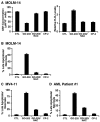MUC1-C oncoprotein suppresses reactive oxygen species-induced terminal differentiation of acute myelogenous leukemia cells
- PMID: 21422470
- PMCID: PMC3100696
- DOI: 10.1182/blood-2010-10-296632
MUC1-C oncoprotein suppresses reactive oxygen species-induced terminal differentiation of acute myelogenous leukemia cells
Abstract
Acute myeloid leukemia (AML) cells are characterized by unlimited self-renewal and an impaired capacity to undergo terminal differentiation. The MUC1 oncoprotein is aberrantly expressed in AML cells; however, there has been no evidence for involvement of MUC1 in myeloid leukemogenesis. Cell-penetrating peptide inhibitors of the MUC1-C subunit block its oligomerization and thereby oncogenic function. The present results demonstrate that treatment of human MOLM-14 and MV4-11 AML cells with these inhibitors is associated with arrest of growth, induction of late apoptosis/necrosis, and loss of self-renewal capacity. Similar results were obtained with primary blasts from patients with AML. Inhibition of MUC1-C was associated with increases in reactive oxygen species (ROS) and depletion of glutathione. Increases in ROS have been linked to induction of hematopoietic cell differentiation along the myeloid lineage. In this regard, inhibition of MUC1-C was associated with induction of a terminally differentiated myeloid phenotype in AML cell lines and primary blasts by an ROS-dependent mechanism. These findings indicate that MUC1-C function is of importance to AML cell self-renewal and that inhibition of MUC1-C represents a potential therapeutic approach to induce terminal differentiation of AML cells.
Figures






Similar articles
-
MUC1 is a potential target for the treatment of acute myeloid leukemia stem cells.Cancer Res. 2013 Sep 1;73(17):5569-79. doi: 10.1158/0008-5472.CAN-13-0677. Epub 2013 Jul 18. Cancer Res. 2013. PMID: 23867470 Free PMC article.
-
MUC1-C oncoprotein promotes FLT3 receptor activation in acute myeloid leukemia cells.Blood. 2014 Jan 30;123(5):734-42. doi: 10.1182/blood-2013-04-493858. Epub 2013 Nov 26. Blood. 2014. PMID: 24282218 Free PMC article.
-
Terminal differentiation of chronic myelogenous leukemia cells is induced by targeting of the MUC1-C oncoprotein.Cancer Biol Ther. 2010 Sep 1;10(5):483-91. doi: 10.4161/cbt.10.5.12584. Epub 2010 Sep 4. Cancer Biol Ther. 2010. PMID: 20592495 Free PMC article.
-
Analysis of the Mechanisms of Action of Naphthoquinone-Based Anti-Acute Myeloid Leukemia Chemotherapeutics.Molecules. 2019 Aug 28;24(17):3121. doi: 10.3390/molecules24173121. Molecules. 2019. PMID: 31466259 Free PMC article. Review.
-
MUC1 in hematological malignancies.Leuk Lymphoma. 2016 Nov;57(11):2489-98. doi: 10.1080/10428194.2016.1195500. Epub 2016 Jun 27. Leuk Lymphoma. 2016. PMID: 27347699 Free PMC article. Review.
Cited by
-
Protein mislocalization: mechanisms, functions and clinical applications in cancer.Biochim Biophys Acta. 2014 Aug;1846(1):13-25. doi: 10.1016/j.bbcan.2014.03.006. Epub 2014 Apr 4. Biochim Biophys Acta. 2014. PMID: 24709009 Free PMC article. Review.
-
MUC1-C drives myeloid leukaemogenesis and resistance to treatment by a survivin-mediated mechanism.J Cell Mol Med. 2018 Aug;22(8):3887-3898. doi: 10.1111/jcmm.13662. Epub 2018 May 15. J Cell Mol Med. 2018. PMID: 29761849 Free PMC article.
-
MUC1 inhibition leads to decrease in PD-L1 levels via upregulation of miRNAs.Leukemia. 2017 Dec;31(12):2780-2790. doi: 10.1038/leu.2017.163. Epub 2017 May 30. Leukemia. 2017. PMID: 28555079 Free PMC article.
-
Identification and characterization of agonist epitopes of the MUC1-C oncoprotein.Cancer Immunol Immunother. 2014 Feb;63(2):161-74. doi: 10.1007/s00262-013-1494-7. Epub 2013 Nov 15. Cancer Immunol Immunother. 2014. PMID: 24233342 Free PMC article.
-
MUC1-C induces DNA methyltransferase 1 and represses tumor suppressor genes in acute myeloid leukemia.Oncotarget. 2016 Jun 28;7(26):38974-38987. doi: 10.18632/oncotarget.9777. Oncotarget. 2016. PMID: 27259275 Free PMC article.
References
-
- Löwenberg B, Downing JR, Burnett A. Acute myeloid leukemia. N Engl J Med. 1999;341(14):1051–1062. - PubMed
-
- Gilliland DG, Jordan CT, Felix CA. The molecular basis of leukemia. Hematology Am Soc Hematol Educ Program. 2004:80–97. - PubMed
-
- Wang ZY, Chen Z. Acute promyelocytic leukemia: from highly fatal to highly curable. Blood. 2008;111(5):2505–2515. - PubMed
-
- Tothova Z, Kollipara R, Huntly BJ, et al. FoxOs are critical mediators of hematopoietic stem cell resistance to physiologic oxidative stress. Cell. 2007;128(2):325–339. - PubMed
-
- Huang P, Feng L, Oldham EA, Keating MJ, Plunkett W. Superoxide dismutase as a target for the selective killing of cancer cells. Nature. 2000;407(6802):390–395. - PubMed
Publication types
MeSH terms
Substances
Grants and funding
LinkOut - more resources
Full Text Sources
Other Literature Sources
Medical
Research Materials
Miscellaneous

